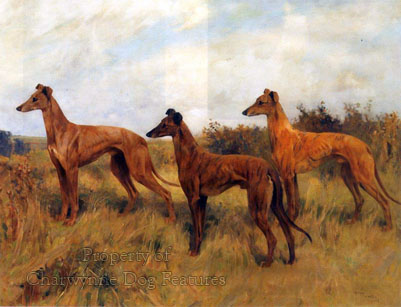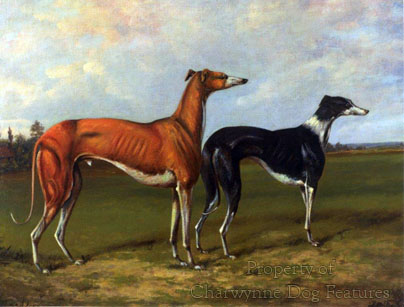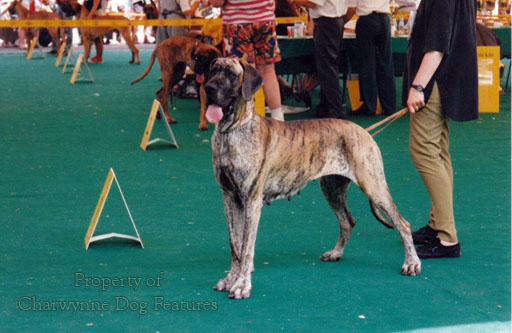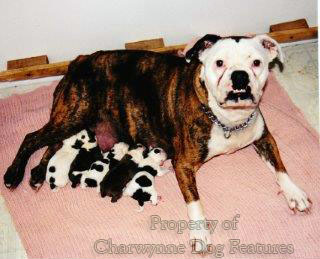271 Breeding Better Breeds
BREEDING FOR THE NEXT MILLENNIUM
by David Hancock
 It is a sad fact that most dog breeders breed on the phenotype, i.e. what the parents look like, rather than the genotype, i.e. what genes are able to be passed on. Breeding living creatures can only ever be an exercise in genetics and breeders seeking to establish a line of consistent type must accept that every dog and bitch mating is a blending of two families not just of a sire and a dam. The phrase which seems to lead to mistaken assumptions is the one that states that a puppy gets 50% of its genes from the sire and 50% from the dam. A better, more accurate, more valuable phrase is that a puppy gets 50% of its genes through its sire and 50% of its genes through its dam. That is why it is simply vital to know what stock is behind the parents of the puppy.
It is a sad fact that most dog breeders breed on the phenotype, i.e. what the parents look like, rather than the genotype, i.e. what genes are able to be passed on. Breeding living creatures can only ever be an exercise in genetics and breeders seeking to establish a line of consistent type must accept that every dog and bitch mating is a blending of two families not just of a sire and a dam. The phrase which seems to lead to mistaken assumptions is the one that states that a puppy gets 50% of its genes from the sire and 50% from the dam. A better, more accurate, more valuable phrase is that a puppy gets 50% of its genes through its sire and 50% of its genes through its dam. That is why it is simply vital to know what stock is behind the parents of the puppy.
 Breeding pedigree dogs is made more risky in Britain by the lack of reliable records. It is automatically assumed that the written pedigree is accurate whereas an alarming proportion of them are not. No dog has to be individually and irrevocably made identifiable by way of a tattoo or microchip. Judges in the show ring and owners of bitches only have someone's word that the dog before them in the ring or the sire being used for the service is the one named on the pedigree or put forward as such. It only needs one prolific breeder to be dishonest for the whole breeding record of a pedigree breed to be made unreliable. The written pedigree too is restricted to number, gender, colour and breed; there is no record of the strengths or faults of the dog on its pedigree despite show critiques containing detailed comment being available after every major show.
Breeding pedigree dogs is made more risky in Britain by the lack of reliable records. It is automatically assumed that the written pedigree is accurate whereas an alarming proportion of them are not. No dog has to be individually and irrevocably made identifiable by way of a tattoo or microchip. Judges in the show ring and owners of bitches only have someone's word that the dog before them in the ring or the sire being used for the service is the one named on the pedigree or put forward as such. It only needs one prolific breeder to be dishonest for the whole breeding record of a pedigree breed to be made unreliable. The written pedigree too is restricted to number, gender, colour and breed; there is no record of the strengths or faults of the dog on its pedigree despite show critiques containing detailed comment being available after every major show.
In Britain there are no mandatory health checks on breeding stock, unlike the vast majority of other countries in which the pedigree dog is looked after by a kennel club. Health checks of course will never represent a 100% assurance of clear stock, a guarantee of faults being present or not, or be an indication of quality by themselves. There are bitches with worryingly high hip scores which regularly produce progeny with low hip scores. There is however no data on the hip health of the next generation from such dogs. No sensible breeder seeks dogs with perfect hips and eyes but lacking breed type or soundness of construction. But dog breeders should have access to sufficient data to enable them to make a balanced judgement. No humane person wants to produce dogs with a built-in likelihood of future lameness, blindness or deafness. But currently no truly realistic attempts, on a proper scientific system, are being made nationally to seek a reduction in the chance of unhealthy or crippled dogs being bred. 

One of the difficulties facing breeders of live animals, whether it be dogs or parakeets, is that professional scientists have made genetics a foreign language. The role of the expert surely is to make a complex subject more easily understood. Scientists are not good at this and yet display impatience when their work is misunderstood or not heeded. Dog breeders know too that there has never been a geneticist among the most successful of them. Geneticists are scientific advisors and breeding is an art as well as a science. They can advise us on how diseases which are inheritable are passed on. They can advise us on how physical and mental characteristics are likely to be passed on. But in the end the skill of the breeder lies in selection, the selection of breeding stock, the selection of parents and the selection of a breeding path to follow.
Selection based on the mere fact that the dam is a nice pet and ought to be bred from, or has won a couple of prizes and her pups will bring in income, or the future chosen sire is a current big winner, contributes little to a breed and even less to the reputation of the breeder concerned. No bitch should be bred from just because she is female and fertile. Puppies should, in the genuine dog-lover's world, never be produced to suit someone's bank balance; there are already too many unwanted and ill-kept dogs in Britain. For any breeder to mate his precious bitch to a dog just because the dog is currently winning well is sheer folly. It assumes that the judges rewarding the sire are knowledgeable and unbiased -- but are they? And even if the sire to be is a worthy champion, what family does he come from? The genes of his ancestors will come through him.
Until we have better data from approved national schemes, selection of breeding stock will rely on the researching skills of each individual breeder. With the accuracy of the written pedigree never being checked by the Kennel Club, just the breeder's word accepted, with no mandatory health clearances, no national dog identification scheme and no information of breeding value on the written pedigree, coupled with untrained judges rewarding unworthy dogs, any breeder faces an uphill battle in the pursuit of breeding better dogs. The appointment of a geneticist for each breed and the appointment of a breed archivist to verify pedigrees, together with a grading system to establish just how good each dog is, would help enormously. Sire ranking lists are available to livestock breeders but not yet to dog breeders -- how long can that continue?
Novice breeders may well despair of finding the essential data on which to base their breeding programme. Veteran breeders usually know that dogs bearing this particular affix display certain good qualities, whilst those bearing another one feature other complementary ones. Shrewd breeders usually utilise an older stud dog, his track record can at least be examined. There is financial sense in a small breeder not kennelling his own stud dog but using outside blood to a well-researched plan.
Long established kennels in every breed often develop their own kennel signature or kennel type. When this conforms precisely to the breed standard, it provides valuable stable genetic material. But when one influential breeder is producing untypical stock, however attractive or successful, it is most important for the novice breeder to detect this. In the end, the breed standard is the breeding blueprint, a design for the future product. Knowledge of it and more important still, an understanding of it, is essential for the successful breeding to type in a pure-bred breed of dog..jpg)
Some breeds have never produced an outstanding breeder. Far too few experienced breeders offer advice in depth to newcomers. I have never been to a breed seminar in which a highly successful breeder has been willing to address the audience on the subject of "My Breeding Method". Advice, good and bad, on how to rear puppies or assist in their whelping is often forthcoming, but rarely informed advice on how to best beget quality pups. Yet away from the show ring, Foxhound breeders have always striven to produce a better hound, by themselves or through other kennels. They have been discussing breeding systems for two centuries, without apparent signs of petty jealousy.
Inheritance, whether it leads to successful Foxhounds, faster Greyhounds, softer-mouthed gundogs, more efficient tracking Bloodhounds or just good-tempered healthy family pets, is not accidental. Empirical evidence is often available. We can learn, for example, that a fawn to fawn mating in Boxers and Great Danes has produced a brindle but it is extremely rare in Bullmastiffs. We know that the brindle factor is handed on very similarly in Whippets, Greyhounds and Great Danes, that Otterhound coat colours are analogous with those of the Bloodhound and that sighthounds are often black or blue but scenthounds relatively rarely.
We are informed that breeds like the Airedale Terrier, the Collie varieties, the Setter family, the Elkhound and the Cocker Spaniel are mute on the trail, but that the Bloodhound, the Foxhound, the Beagle, the Dachshund and Sussex Spaniel are 'open' trailers, that is they give tongue on the trail. The 'treeing' aptitude, the head held high for air scent or low for ground scent, the tendency to mouth prey rather than kill it quickly and the impulse to 'hold' or 'pin' rather than 'slash' at a running quarry, are all inherited as distinctly as more visible characteristics.
Geneticists also tell us that the brindle factor is a limit to a black coat which only manifests itself in black cross stripes and a black mask extending to a black muzzle. The mask factor is a limit to a black coat so that only the mask and muzzle can be black, the remainder of the dog is red or fawn or shades of these. Short hair is genetically dominant over long hair and there are genes which modify leg length, with short crooked legs incompletely dominant over normal straight legs.
There is a certain relation between the dog's coat and its eye and nose colour. The colour of the tip of the nose closely agrees with the colour of the lips and the balls of the feet. Hanging ears are dominant over upright ears, yet semi-erect ears are dominant over upright ears. A sharp nose is dominant over a blunt nose. the overshot jaw is more likely to be inherited than the undershot one. The short tail is dominant over the long tail. The desire to enter water. strong in the Newfoundland, weak in the Bullmastiff and Bloodhound, is a dominant factor. Many different genes are responsible for ear and tail position.
Variation within the brindle and fawn patterns of coat applies similarly to Boxers and Bullmastiffs, with indications that the black mask and muzzle is dominant over no black mask and muzzle. Brindle to brindle matings in Boxers and Great Danes produce more than five times as many brindle pups as fawns. But just as there are known characteristics of colour inheritance so too are there of temperament and learning ability. No amount of training can make a mentally sluggish dog into a mentally alert, eager to learn dog. Excitable, excessively nervous, highly strung dogs or dogs with untrustworthy tempers are exhibiting inherited characteristics and should not always be bred from.
The facts or tendencies or breed predispositions advised to us by geneticists are of value to breeders when planning specific breeding programmes using named dogs. Such genetic facts however have limited value unless they can be linked to schemes covering the genetic health of a breed, the verified accuracy of written pedigrees, the unambiguous identification of individual dogs and recorded family histories, showing strong points and weaker ones in the line. By appointing a geneticist for each breed, supported by a breed archivist, and by initiating a breed survey, the likelihood of obtaining improved quality in a breed can be enhanced. Trained qualified judges are more likely too to reward the best dogs and identify the best breeding material than those offered such an appointment because of their length of service, frequency of judging or past record as a prolific breeder.
Small breeders need to have more knowledge than those who in past times could support a kennel housing hundreds of dogs. The quality of pedigree dog seen in so many breeds in far too many show rings reflects the amateur ill-informed manner in which all too many breeders approach their hobby. If you do go ahead and mate your pet bitch with the best in show at Crufts of your breed then don't be surprised if you get indifferent stock, which resemble the poor quality of their grandparents. You will be getting what you deserve and it will be an expensive lesson. But you will not be the first or last to try such a slipshod method. Sadly, genetics is not the science of optimism! As we enter the next millennium, a genuinely scientific basis for dog breeding is screamed out for. Only then will the 21st century British dog be, as Shakespeare put it in Richard II, "Fear'd by their breed and famous by their birth."